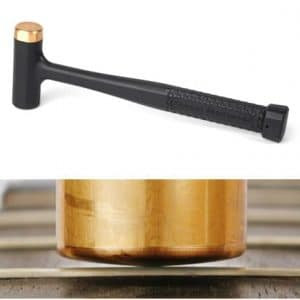Installing frets is a crucial step in guitar building and maintenance. Ensuring each fret is perfectly seated is vital for optimal playability, intonation, and the overall lifespan of the instrument. For those new to guitar building or fretwork, the array of tools and methods can seem overwhelming. This article will demystify the process by focusing on two primary tools for fret installation: the fret hammer and the fret press. We’ll explore the strengths and weaknesses of each, helping you determine the best approach for your needs and skill level when working with guitar frets.
Understanding Guitar Frets and Installation
Guitar frets are the thin metal strips embedded in the fingerboard that define the notes when you press down a string. Their accurate and secure installation is paramount. Improperly installed frets can lead to buzzing, dead spots, intonation problems, and a generally unpleasant playing experience. The goal of fret installation is to seat the fret wire firmly and evenly into its slot, creating a consistent and level playing surface across the guitar neck. Achieving this tight fit is key to minimizing future fretwork and maximizing the guitar’s sonic potential.
Hammering Guitar Frets: The Traditional Approach
 Dead blow hammer for guitar fret installation
Dead blow hammer for guitar fret installation
The hammer method is often the first technique guitar builders encounter, largely due to its accessibility and lower initial cost. Using a specialized dead-blow fret hammer, the fret wire is carefully tapped into the fret slot. While seemingly straightforward, mastering this technique requires practice and a keen understanding of the nuances involved.
Pros of Hammering Frets:
- Cost-Effective Entry: A basic fret hammer is significantly less expensive than a fret press, making it an attractive option for beginners or those on a tight budget.
- Accessibility Over the Guitar Body: The hammer method is particularly useful when working on the guitar body, such as during refretting or repairs where access can be limited. It’s also convenient for working on finished necks where maneuvering a larger press might be cumbersome.
- Ideal for Refrets and Repairs: Hammering is often favored for refretting jobs and repairs on finished guitars because it allows for localized work without needing to remove the neck or disassemble the instrument further.
Cons of Hammering Frets:
- Potential for Fret Sprout: One of the biggest challenges with hammering is the risk of causing fret ends to lift or “spring up” if the force isn’t applied evenly. This can lead to uneven fret seating and require additional leveling work.
- Noise and Vibration: Hammering is inherently loud, necessitating hearing protection. The vibrations can also be a concern, especially when working on delicate or finished instruments.
- Steeper Learning Curve: Achieving consistently well-seated frets with a hammer requires developing a feel for the right amount of force and technique. It often involves a period of practice and experimentation to master.
Fret Press for Guitars: Precision and Efficiency
 Guitar fret press caul with radius inserts for precise fret seating
Guitar fret press caul with radius inserts for precise fret seating
A fret press offers a more controlled and often more efficient alternative to hammering. Fret presses come in various forms, from simple drill press attachments to dedicated bench-mounted systems. The core principle involves using mechanical advantage to press the fret wire into the slot with consistent, even pressure. Many fret presses utilize radius-specific cauls, which ensure the fret is pressed in with the correct curvature, further enhancing seating and reducing the likelihood of issues.
Pros of Using a Fret Press:
- Consistent and Even Seating: The fret press excels at providing even pressure across the entire fret, minimizing the chance of fret ends lifting and ensuring a uniformly seated fret. This leads to less leveling and dressing work later on.
- Faster Installation Workflow: Once set up, a fret press can significantly speed up the fret installation process, especially when working on multiple guitars or necks.
- Quiet Operation: Unlike hammering, a fret press operates quietly, creating a more peaceful and less disruptive working environment.
Cons of Using a Fret Press:
- Higher Initial Cost: Fret presses are generally more expensive than fret hammers, representing a larger upfront investment.
- Setup and Maneuverability: Setting up a fret press can require more time initially, and they can be less maneuverable when working over the guitar body or on finished necks. While possible, it may require more careful planning and setup.
- Radius Matching: While radius cauls are a benefit, it’s crucial to have cauls that accurately match the fingerboard radius. A mismatch can lead to uneven pressure and potential issues. Some presses may not automatically compensate for slight variations in fingerboard radius.
Hybrid Approach: Combining Hammer and Press for Optimal Guitar Frets
Many experienced luthiers, including myself, find that a hybrid approach, combining the benefits of both hammering and pressing, yields the best results for guitar frets installation. This method often involves using a fret press for the initial seating of the fret wire, taking advantage of its even pressure and speed. Then, a fret hammer is used for fine-tuning, ensuring the fret ends are perfectly seated and addressing any minor inconsistencies.
This combined technique allows you to leverage the strengths of each tool while mitigating their weaknesses. The press provides the foundation of a well-seated fret, and the hammer offers the precision for final adjustments. Experimentation is key to discovering the combination that works best for your individual style and the specific guitars you are working on.
Ultimately, the best tools and methods for installing guitar frets depend on your budget, experience level, and the type of work you are undertaking. Whether you choose the traditional hammer, the precise fret press, or a combination of both, mastering fret installation is a rewarding skill that significantly impacts the quality and playability of your guitars.
